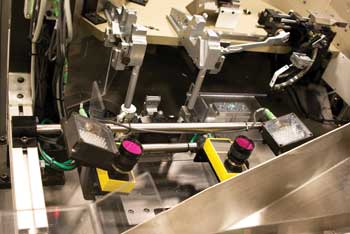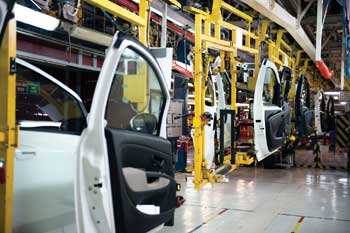Industry experts share their thoughts on the market’s present and future.
Machine vision is arguably one of the keys to efficient manufacturing: From automation to inspection and quality control, vision technologies enable manufacturers to produce higher-quality goods at a faster pace. And Europe is a driving force in the machine vision market.
For a closer look at the market, EuroPhotonics spoke with Gabriele Jansen, the CEO of Vision Ventures in Heppenheim, which is south of Frankfurt, Germany; her company, a boutique M&A advisory firm, specializes in the machine vision and photonics industries. We also spoke with two members of EPIC, the European Photonics Industry Consortium: Dr. Thomas Kessler, executive vice president for global sales at Edmund Optics and managing director of Edmund Optics GmbH in Karlsruhe, Germany, as well as of Edmund Optics SARL in Lyon, France; and Dr. Markus Ehbrecht, managing director of Qioptiq Photonics in Munich.

Machine vision enables faster and more efficient manufacturing processes.
Q: What do you see as the “next big thing” in machine vision? Which application areas would you say are thriving – and why?
Jansen: The “next big thing” in machine vision in general is probably the multidimensional extension of the image data input: Increasingly, image data beyond the input from a typical gray-level camera is [used]. This can be witnessed with the increase of 3-D sensors generating three-dimensional information as well as with the advent of affordable multispectral imaging solutions, making use of spectral data from the edges of the visible bandwidth.
Both developments open up additional applications and use fields for machine vision in manufacturing … as well as in other industries [such] as traffic, surveillance and entertainment.
Kessler: The automation in manufacturing remains the biggest application in general. End markets vary [over] time, but semiconductor and consumer electronics manufacturing – e.g., for flat panel displays (TFT, OLED, PDP) and electronics for game consoles – will stay one of the main applications. We expect further growth in automotive manufacturing as well. Although photovoltaics is currently hampered due to the reduced governmental subsidies, the application will likely survive and stay big. Logistics is likely going down, with RFID replacing bar codes in many applications.

The automotive market for machine vision is expected to grow, as is the European machine vision market
in general.
Ehbrecht: In general, we have typically increasing requirements regarding resolution, aperture and larger image size. On top of that, we see that adaptive optics will be game-changing technology. Focusing by means of liquid lenses is one prominent example that is already in use for certain applications. Qioptiq supplies some products based on this technology for various applications.
Q: How would you say the European market has been in the past few years for machine vision? And how does it differ from the global market?
Jansen: The European market for machine vision is still the biggest market on a global scale. The level of automation and the adoption level of the whole range of machine vision products – from simple and easy to use up to sophisticated and complex – is nowhere else as high as in Europe. This also leads to a European machine vision industry that is bigger in size and more diverse than [the industry]in other areas of the world. In Europe, you can find excellent developers of core technology, like image sensors and image-processing algorithms, as well as excellent vision products from cameras to sensors, from software to systems, as well as a wide range of vision solution providers for all kinds of applications and industries.
Kessler: Growing steadily but [at] a slow pace. The market is rather high value … small units for manufacturing in automotive, logistics – e.g., bar codes and pharmaceuticals/medicals for safe recognition.
Ehbrecht: The European market is relatively stable and continuously growing. This is due to the fact that European machine makers equip Asian factories and participate in the growth of Asia while making use of European machine vision components. On the other hand, domestic use of machine vision equipment in factories in Europe is quite stable.
Q: Where do you think the market is going?
Jansen: Having sung the praise of the European market and industry already, it is also true that the market is significantly moving towards Asia. Many new production lines in many different industries are no longer built in either Europe or the US, but in Asia. Consequently, this is where automation is needed, and this is then also where machine vision is needed.
Currently, the European players benefit from this development and can report high export rates. However, history shows that the local suppliers will grow stronger over time, and then market and industry will more likely than not focus in Asia. As this development is very much dependent on the development of the manufacturing industry, paradigm changes in this industry might change the future picture. Also, machine vision applications outside the manufacturing industries will certainly continue to thrive in Europe.
Kessler: Consumer mass production will likely stay in Asia, but the medical and pharmaceutical markets will likely require more and more recognition and identification devices. Security might be another application area that will grow in Europe. Machine vision in manufacturing will probably venture into other areas with decreasing component and system prices. Smart integration will stay a requirement.
Ehbrecht: The market will expand for the coming years. Especially, the nonindustrial market is driving market growth with new applications of traditional machine vision components. At the same time, the market is, more and more, diversifying – and components will be tailored towards special applications with unique requirements.
Q: What are the biggest challenges to new advances in machine vision?
Kessler: Smart integration, price reduction requirements for systems that would allow broader application, standardization which would allow [users] to integrate and run machine vision [systems] without additional experts on-site as well as have cost trade-offs for exchangeability of devices.
Ehbrecht: In general, total cost of ownership is the driving factor for advances in machine vision applications.
Jansen: I see challenges coming from different directions: technical challenges, but also industry challenges. The main technical challenge, or challenge for machine vision products, is the consumer expectation for ease of use. With every image-based smartphone app like image recognition in social networks, augmented reality for tourists or the reading capabilities required for automated translation of restaurant menus, the user moves further in the direction of expecting the same intuitive use from his industrial vision devices. At the same time, the sensory input gets more complex, as pointed out earlier. This is a huge challenge for the device and software designers and developers in our industry.
Another challenge for the industry as a whole is the increase of consolidation and the entry of new players from outside the traditional machine vision industry with larger size and different corporate culture. On an individual level, each company has to deal with these changes, especially since a lot of the vision entrepreneurs from the first hour are becoming interested in managing a generation change or a change in ownership.
On an industry level, it will be a challenge to maintain the innovative and creative spirit while transitioning into a more consolidated industry with larger players having larger overheads and necessarily less flexible structures than the typical machine vision SME of today.